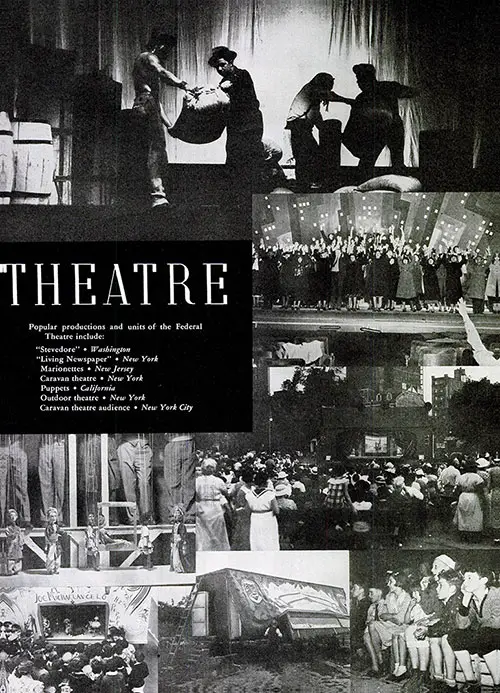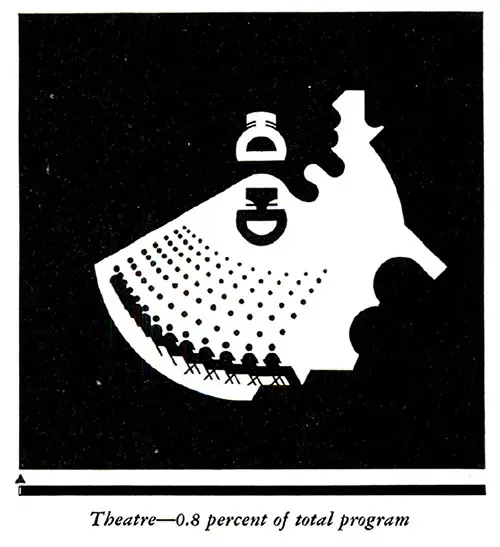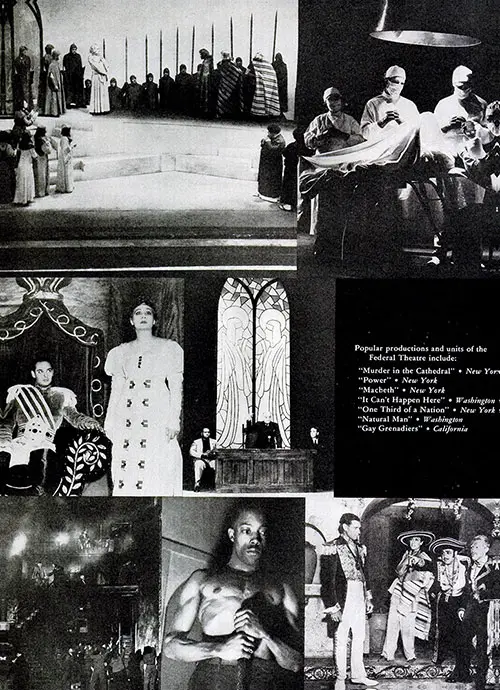🎭 The WPA Federal Theatre Project: How Public Theatre Transformed American Culture During the Great Depression
📌 The WPA Federal Theatre Project (1938) provided thousands of artists with jobs while making theatre accessible to millions. Discover how this initiative reshaped American theatre, pioneered new storytelling techniques, and launched the careers of legendary performers.

Collage of Popular Productions and Units of the WPA Federal Theatre Include "Stevedore" (Washington), "Living Newspaper" (New York), Marionettes (New Jersey), Caravan Theatre (New York), Puppets (California), Outdoor Theatre (New York), Caravan Theatre Audience (New York). Inventory: An Appraisal of Results of the Works Progress Administration, Washington, DC: US Government Printing Office, 1938. | GGA Image ID # 1526f7d18b
🎭 WPA Federal Theatre Project - 1938
Bringing Theatre to the People & Rescuing Artists During the Great Depression
📖 The WPA Federal Theatre Project (FTP) was one of the most ambitious government-sponsored arts initiatives in U.S. history. This article provides a detailed account of how the FTP revitalized American theatre, employed thousands of artists, and introduced live drama to millions of people who had never experienced it before. With a strong emphasis on accessibility, social themes, and artistic innovation, the project played a pivotal role in shaping modern American theatre. This document is invaluable for teachers, students, genealogists, theatre historians, and cultural scholars seeking insight into one of the most significant public arts programs of the 20th century.
For educators, historians, and theatre enthusiasts, this document provides:
✔️ A comprehensive record of how the WPA employed thousands of actors, directors, playwrights, and stagehands.
✔️ Examples of innovative productions that tackled social and political issues.
✔️ Insights into how theatre was used as an educational and therapeutic tool.
✔️ Evidence of how the FTP laid the foundation for public theatre programs across the U.S.
📌 This report highlights the importance of government support for the arts, proving that public funding can sustain artistic innovation while making theatre accessible to diverse audiences.
The WPA Federal Theatre Project, designed to give work to the theatre's unemployed, has brought living drama to millions of people through a total of 1,501 productions of all types, in 40 cities of 22 States.

Topical Title Page for WPA Theatre Projects Representing 0.8 Percent of Total Program. Inventory: An Appraisal of Results of the Works Progress Administration, Washington, DC: US Government Printing Office, 1938. | GGA Image ID # 1527848418
The Federal Theatre gives an average of 2,833 performances each month—nearly 100 per day—to a total average monthly attendance of more than 1,000,000 people. Sixty-five percent of these shows are free, and they are staged not only in city theatres but in community halls, tents, schools, prisons, armories, churches, parks, hospitals, and CCC camps.
Even when admission is charged it is nominal. Nearly two-thirds of those who have seen these plays, it has been found by the use of questionnaires, never before had seen a play with living actors.
At its peak, the Federal Theatre employed 12,700 actors, designers, technicians, play- wrights, theatre musicians, stagehands, ushers, maintenance workers, and box-office, accounting, and secretarial people. The number is now about 8,700. More than nine out of ten of these workers come from the relief rolls, and $9 out of every $10 of the appropriation goes for wages.
There are the essential operating facts concerning the WPA project designed to give work to the theatre3s unemployed, one of the groups hardest hit by depression and by advances in technology.
As with the other arts projects, it was based on the idea that artists can get just as hungry as laborers, that their training has been expensive and is an asset worth saving, and that their best chance for private jobs lies in the field they know best.
But if these show-people were to get back into the private theatre they had to demonstrate their ability; and if the living theatre was to be revived by recreating a demand for it, the productions had to be vivid, vital, and compelling.
The Federal Theatre undertook this awesome objective in the face of many handicaps. With little money to spend on elaborate staging, it worked out simple and striking techniques through the use of light and shadow.
It delved deeply into rich historical aspects of national development, faced controversial current problems with arresting courage. The verdict on its artistry is best given by a few of the many critics who praised its work.
Sinclair Lewis voiced his "tremendous enthusiasm," and released the dramatization of his anti-dictatorial It Can't Happen Here for simultaneous production by 21 Federal Theatre units.
Samual Eliot Morrison, professor of history at Harvard, expressed his "hearty approval," while Burns Mantle declared the project "has turned the theatre back to the people, to whom it rightfully belongs."
Gilbert Seldes said in 1936, "The Federal Theatre was, at the end of last season, by far the most interesting, and probably the most successful of theatre impresarios in New York."
Paul Green, the teacher and playwright, called it "the most important thing ever to occur in the history of the American drama." Others who have found merit in its work are too numerous to list, but they include such names as Atkinson, Garland, Stevens, Lewis, Brown, Lockridge, Young, Rosen field, Oliver, Hay, Glass, Davney, Graves, Whitman, and Sugarman.
Federal Theatre productions are of many types. In the "purely entertainment" cate- gory would fall circuses, marionette shows, musical comedies, Gilbert and Sullivan and other light operas, and a series of satirical musical revues designed to use a wide variety of vaudeville talent.
The classical aspect of the theatre is represented by such plays as the Negro Macbeth, Marlowe's Dr. Faustus, Coriolanus and Trojan Incident. George Bernard Shaw and Eugene O'Neill, both of whom have approved Nationwide WPA cycles of their plays, also merit this classification.
The project emphasizes important dance groups, as in New York, Chicago, and Los Angeles; the theatre of youth, with such plays as Hansel and Gretel, Pinocchio, and Treasure Island; the Negro theatre, with special units where feasible; and the radio.
In addition to the research and experimentation necessary to its new approach, the project is studying the theatre as a force in education, therapy, and prison welfare. Its hand marionette companies work in hospitals with children whose hands are paralyzed.
Marionette companies in Buffalo and Miami have dramatized Death Takes the Wheel and are used by local police to campaign against reckless driving.
The largest field of the Theatre Project, however, is that of new plays based on American life, whether involving legendary or historic figures such as John Bunyan, Davy Crockett, John Brown, and Abraham Lincoln, or dealing with current problems, as in the Living Newspaper treatments of such moot topics as agriculture, housing, power, and labor.
As to rehabilitation of the workers, more than 1,500 have returned to private jobs, and almost every Broadway cast in 1937-38 contained actors from the project. Examples—Shadow and Substance, Of Mice and Men, You Can't Take It With You, I'd Rather be Right. And the Mercury Theatre, new dramatic group, drew producer, director, designer, and many leading actors from the Federal Theatre.

Collage of Other Popular Productions and Units of the WPA Federal Theatre Include "Murder in the Cathedral" (New York), "Power" (New York), "Macbeth" (New York), "It Can't Happen Here" (Washington), "One Third of a Nation" (New York), "Natural Man" (Washington), "Gay Grenadiers" (California). Inventory: An Appraisal of Results of the Works Progress Administration, Washington, DC: US Government Printing Office, 1938. | GGA Image ID # 15273edade
"Theatre," in Inventory: An Appraisal of Results of the Works Progress Administration, Washington, DC: US Government Printing Office, 1938, pp. 75-78.
Why This Document is Important
📜 Relevance for Different Audiences
✔ For Theatre Educators & Drama Teachers
🔹 Provides historical context for how government funding helped sustain live theatre.
🔹 Demonstrates how public theatre programs can foster creativity and provide career training.
🔹 Shows how theatre can be used for social activism and public engagement.
✔ For Historians & Genealogists
🔹 Documents the employment of thousands of theatre professionals, offering valuable records for genealogy research.
🔹 Reveals how theatre was used to promote civic education and national identity.
🔹 Explains how the FTP responded to economic crises and technological changes in entertainment.
✔ For Playwrights, Actors, & Theatre Directors
🔹 Highlights how public theatre programs can be used to support emerging artists.
🔹 Illustrates how the FTP pioneered experimental theatre techniques, including the "Living Newspaper" format.
🔹 Explores how theatre can be used as a platform for storytelling, education, and activism.
📌 This document validates the power of theatre as a tool for employment, education, and social change.
::::: Most Engaging & Insightful Content :::::
🎭 A National Theatre Movement for the People
✔ Why This is Fascinating:
🔹 The WPA FTP staged more than 1,500 productions in 40 cities across 22 states.
🔹 Over 65% of performances were free, making theatre accessible to millions who had never seen a play before.
🔹 Performances took place not just in theatres but also in schools, parks, prisons, hospitals, and even tent shows.
✔ Key Takeaway:
**The WPA FTP brought theatre to the masses, proving that the performing arts could thrive outside traditional venues.
📌 This section is vital for theatre historians, public arts advocates, and cultural policymakers.
🎬 The Living Newspaper & Theatre for Social Change
✔ Why This is Fascinating:
🔹 The "Living Newspaper" was a groundbreaking format that dramatized real-life issues, including agriculture, housing, and labor.
🔹 Productions like "Power" and "One Third of a Nation" educated audiences on pressing social and political topics.
🔹 This type of theatre directly influenced later documentary and political theatre movements.
✔ Key Takeaway:
The FTP used theatre as a form of journalism, raising awareness of contemporary issues and engaging audiences in civic discourse.
📌 This section is crucial for journalists, social activists, and theatre practitioners interested in documentary theatre.
🎟️ Reviving Classical & Experimental Theatre
✔ Why This is Fascinating:
🔹 The FTP staged classical works like Shakespeare’s "Macbeth" (with an all-Black cast), "Doctor Faustus," and "Coriolanus."
🔹 George Bernard Shaw and Eugene O’Neill approved WPA cycles of their plays, ensuring high artistic standards.
🔹 Innovative productions explored new staging techniques using light and shadow rather than expensive set designs.
✔ Key Takeaway:
The WPA FTP helped revive interest in classical and experimental theatre, making high art accessible to general audiences.
📌 This section is essential for theatre directors, Shakespearean scholars, and drama educators.
🎨 Theatre as a Training Ground for Future Stars
✔ Why This is Fascinating:
🔹 Over 1,500 FTP actors, playwrights, and designers later transitioned into mainstream theatre and Hollywood.
🔹 FTP actors performed in Broadway hits like "Of Mice and Men" and "You Can’t Take It With You."
🔹 The Mercury Theatre, led by Orson Welles, drew many of its key members from the FTP.
✔ Key Takeaway:
The WPA helped launch the careers of legendary actors, directors, and playwrights who shaped American theatre and film.
📌 This section is valuable for film historians, theatre students, and Hollywood researchers.
🖼 Noteworthy Images & Their Significance
🖼 🎭 "Collage of Popular Productions and Units of the WPA Federal Theatre"
🔹 Features productions like "Stevedore," "Macbeth," and "Living Newspaper," showcasing the project’s diversity.
🔹 Demonstrates how the FTP mixed entertainment with political and educational themes.
🖼 🎟️ "Collage of Other Popular Productions and Units of the WPA Federal Theatre"
🔹 Highlights key performances like "Murder in the Cathedral" and "It Can’t Happen Here."
🔹 Emphasizes the project’s national impact by showing productions from various states.
📌 These images visually capture the scope and artistic ambition of the WPA FTP.
Bias & Perspective Considerations
✔ Government-Centric View:
🔹 The report emphasizes the project’s successes but does not:
🔹 Address political controversies, including accusations of leftist influences.
🔹 Discuss criticisms from private theatre companies about competition for audiences.
🔹 Explore the long-term sustainability of public-funded theatre.
✔ Overlooking Regional & Racial Disparities
🔹 Did Southern and rural states receive equal funding and opportunities for productions?
🔹 Was the diversity of American theatre fully represented in terms of racial and ethnic storytelling?
🔹 How were women and marginalized communities represented in FTP productions?
📌 While the report highlights the positive impact of public theatre, a deeper analysis would explore the program’s political challenges and cultural limitations.
Final Thoughts: Why This Report Matters
"WPA Federal Theatre Project - 1938" serves as a powerful testament to how public investment in the arts can preserve jobs, expand artistic expression, and bring theatre to new audiences. By funding innovative productions, reviving classical theatre, and training future generations of artists, the FTP shaped American cultural history in ways that continue to resonate today.
📌 This document reminds us that government-backed theatre is not just entertainment—it’s a vital public service, a tool for education, and a force for social change. 🎭🎟️🎤
